Dreaming of zen while your garden looks more like a war zone? I feel you.
I’ve learned that minimalism is key in Japanese bamboo borders. Mixing Phyllostachys with ferns and mosses creates that tranquil vibe we’re all desperately chasing.
Curved bamboo edging? Absolute game-changer. My first attempt looked more like a drunk snake than an elegant border, but practice makes perfect.
Natural stones paired with bamboo create texture contrasts that’ll make your neighbors secretly take photos. Trust me, nothing says “I’ve got my life together” quite like a perfectly balanced bamboo garden border.
My Bamboo Disaster: What Not to Do When Creating a Japanese Garden
The day I planted running bamboo without barriers remains infamous in my neighborhood. Within months, my “contained” Phyllostachys aureosulcata had invaded three adjacent yards, earning me some colorful new Japanese vocabulary from my elderly Japanese neighbor, Mrs. Tanaka.
She eventually took pity on me, teaching me proper containment techniques using 30-inch deep rhizome barriers. Now I carefully select clumping varieties like Fargesia and properly space my Japanese maples and hakone grass. The stone pathway I installed creates natural divisions while complementing my shishi-odoshi water feature.
Sometimes gardening wisdom comes at the cost of neighborly relations, but my garden finally achieves that elusive wabi-sabi balance Mrs. Tanaka kept mentioning.
Quick Takeaways
- Incorporate traditional bamboo fencing for serene, minimalistic garden borders, enhancing tranquility with natural materials and simple designs.
- Use curved bamboo edging to define pathways, adding charm and elegance while allowing for a diverse plant arrangement.
- Layered bamboo planters create multi-level borders, showcasing varying plant heights and textures for visual interest.
- Combine bamboo with textured stones for a natural aesthetic, using different sizes and colors to enhance the garden border.
- Select suitable plants like Japanese Maples and ferns to complement bamboo borders, ensuring a harmonious and cohesive design.
Traditional Japanese Bamboo Fencing

Traditional Japanese bamboo fencing creates tranquil outdoor spaces by featuring natural materials and simplistic designs. Ideal sizes range from 4×8 feet for smaller gardens to larger expanses for spacious settings.
Arrange your planting bed in a symmetrical layout, harmonizing plants with bamboo barriers that evoke serenity. Commonly used materials include bamboo canes, natural stone, and gravel for pathways.
Plants suitable for this bed include lush ferns, flowering cherry blossoms, and evergreen shrubs, enhancing the rustic yet elegant aesthetic. Additionally, incorporating sculptural minimalist elements can elevate the overall aesthetic of your garden by adding a modern touch to the traditional design.
Selecting Plants for a Japanese Bamboo Fencing Planting Bed
When choosing plants, consider their growth habits and compatibility with bamboo aesthetics. Suggested plants for this bed include:
- Japanese Maple (Acer palmatum)
- Hemlock Spruce (Tsuga canadensis)
- Bamboo Varieties (Phyllostachys)
- Hostas
- Azaleas (Rhododendron)
Designing a Traditional Japanese Bamboo Planting Bed
To create your planting bed, begin with a blueprint. Consider these tips:
- Use a balanced mix of evergreen and seasonal plants.
- Space plants depending on their mature size (generally 18-24 inches apart).
- Integrate gravel or moss around the base for a natural look.
Pro Tip: Layer taller plants at the back and shorter ones in the front to enhance visibility and depth.
Seasonal Care and Maintenance for Your Japanese Bamboo Planting Bed
Maintain regular watering, apply balanced fertilizer in spring, perform light pruning to shape during the growing season, and monitor for pests like aphids throughout the year.
Minimalist Bamboo Borders
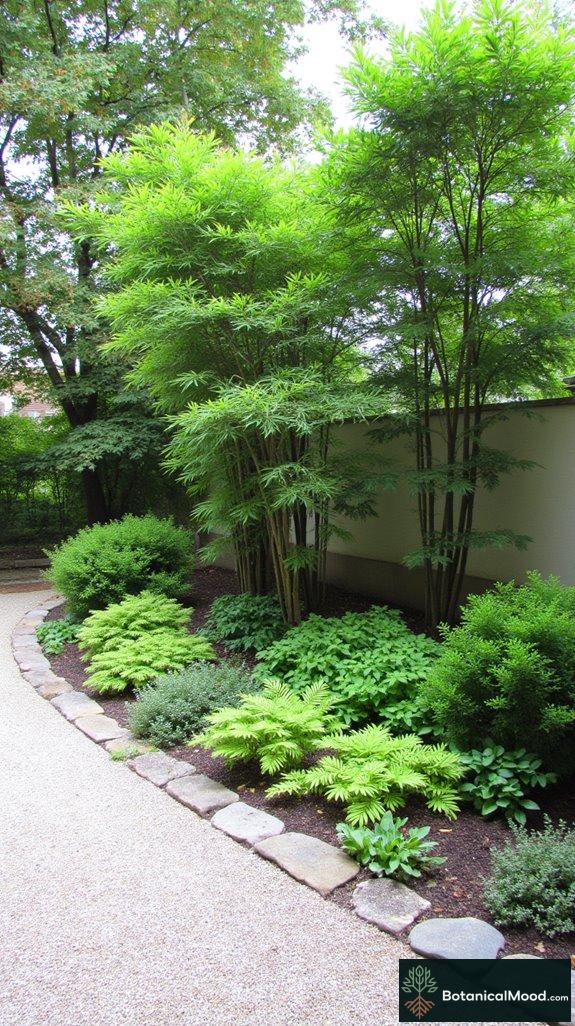
Minimalist bamboo borders create a serene and elegant space in your garden. Typically, these planting beds range from 3 to 5 feet in width and can be arranged in straight lines or gentle curves, mimicking the fluidity of natural surroundings.
Delectable plants that work well with bamboo include dwarf Japanese maples, ferns, and mosses, which add texture and interest. Opt for materials like natural stones or gravel to enhance the minimalist aesthetic. The result is a tranquil space that emphasizes simplicity, allowing the beauty of bamboo to shine.
Choose delightful plants like dwarf Japanese maples and ferns to complement bamboo, enhancing simplicity and tranquility in your garden.
How to Select Plants for Your Minimalist Bamboo Border
Choose plants that complement the elegance of bamboo while maintaining a clean aesthetic. Suggested plants include:
- Dwarf Japanese Maple (Acer palmatum)
- Blue Fescue (Festuca glauca)
- Hakone Grass (Hakonechloa macra)
- Japanese Sedge (Carex morrowii)
- Ferns (various species for lush texture)
Designing Your Minimalist Bamboo Border for Ultimate Appeal
When designing your bamboo border, consider these essential tips:
- Layout: Create linear, asymmetrical or circular designs with bamboo as the focal point.
- Spacing: Space plants about 1-2 feet apart to promote air circulation while maintaining a dense look.
- Pro Tip: Use odd numbers of plants for a more natural appearance and allow for seasonal visuals.
Seasonal Care and Maintenance for Your Minimalist Bamboo Bed
Maintaining your bamboo border involves regular watering, seasonal fertilizing, light pruning to encourage growth, and vigilant pest control throughout the year.
Curved Bamboo Edging
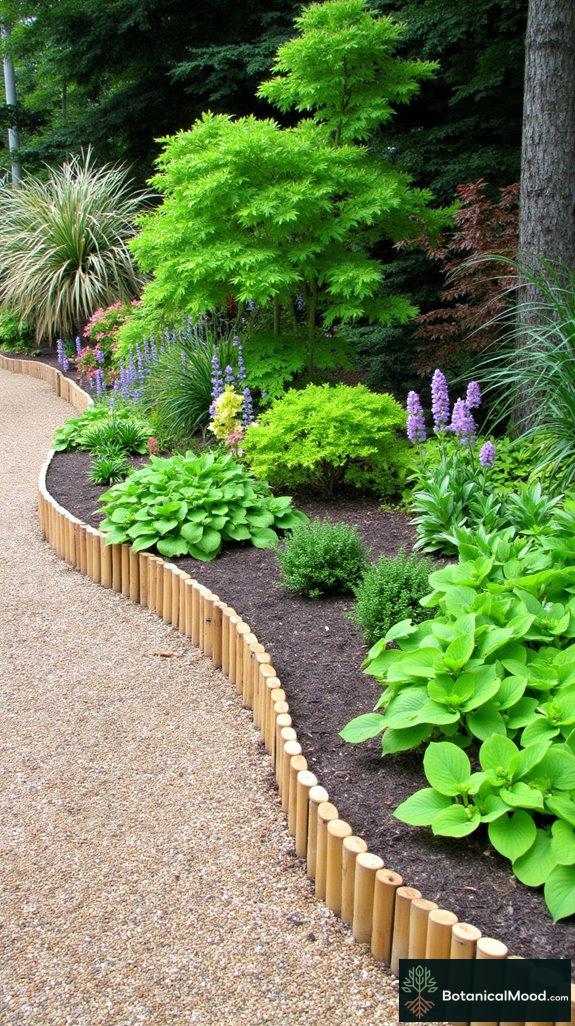
Curved bamboo edging creates an enchanting, serene planting bed, ideal for defining garden pathways or flower boundaries. Typically, these borders range from 12 to 24 inches in height and can be arranged in elegant, flowing lines or gentle curves, mimicking the natural scenery.
Numerous plants can thrive in this setting, featuring lush greenery and colorful blooms alongside the bamboo. Materials often used include treated bamboo poles or flexible bamboo fencing, ensuring durability while blending seamlessly with the garden’s aesthetics.
Selecting Plants for Curved Bamboo Edging
When choosing plants for your bamboo-edged bed, consider a mix of height, texture, and color:
- Japanese Maples
- Hostas
- Ferns
- Sedum
- Ornamental Grasses
- Astilbe
Designing a Curved Bamboo Planting Bed
To design your curved bamboo bed, follow these essential steps:
- Plan the Shape: Sketch your desired curved layout.
- Choose a Variety: Select plants focusing on diverse textures and colors.
- Space Accordingly: Place taller plants at the back and shorter ones in front; aim for 1-2 feet of spacing between each.
- Pro Tip: Use scale drawings to visualize the arrangement before planting.
- Layer Plants: Consider the light requirements, with sun-loving species on the outer edge.
Seasonal Care and Maintenance for Curved Bamboo Beds
Regularly water, fertilize, and prune plants while keeping an eye out for pests throughout the year to maintain a healthy and vibrant garden.
Layered Bamboo Planters

Layered bamboo planters are a stunning way to create multi-level garden beds that showcase the graceful aesthetics of bamboo while providing ample space for various plants. Typically ranging from 2 to 4 feet in height, these planters are arranged in tiers, allowing for an alluring layered look. Additionally, consider incorporating modular raised bed systems for an organized and efficient gardening layout.
Use materials such as natural bamboo shoots, treated wood, or weather-resistant composites. Ideal plants for layered bamboo planters include vibrant ornamental grasses, colorful perennials, and cascading vines to complement the elegant structure.
How to Select Plants for Layered Bamboo Planters
When selecting plants for your layered bamboo planters, consider sun exposure and moisture requirements. Here’s a list of suitable plants:
- Ornamental Grasses (e.g., Japanese Blood Grass)
- Lush Ferns (e.g., Maidenhair Fern)
- Colorful Perennials (e.g., Hostas, Daylilies)
- Cascading Vines (e.g., Morning Glories)
Designing Your Layered Bamboo Planter Bed
To design a stunning layered bamboo planter bed, follow these planning tips:
- Choose a sunny position for peak light (6-8 hours).
- Establish a tiered layout, guaranteeing stability with wider bases at lower levels.
- Space plants according to their mature size (pro tip: don’t overcrowd).
- Consider color and texture contrasts for visual appeal.
Seasonal Care and Maintenance for Layered Bamboo Planters
Regularly water and fertilize plants, prune back dead growth each season, and watch for pests to promote the health of your layered bamboo planter throughout the year.
Bamboo and Stone Combination
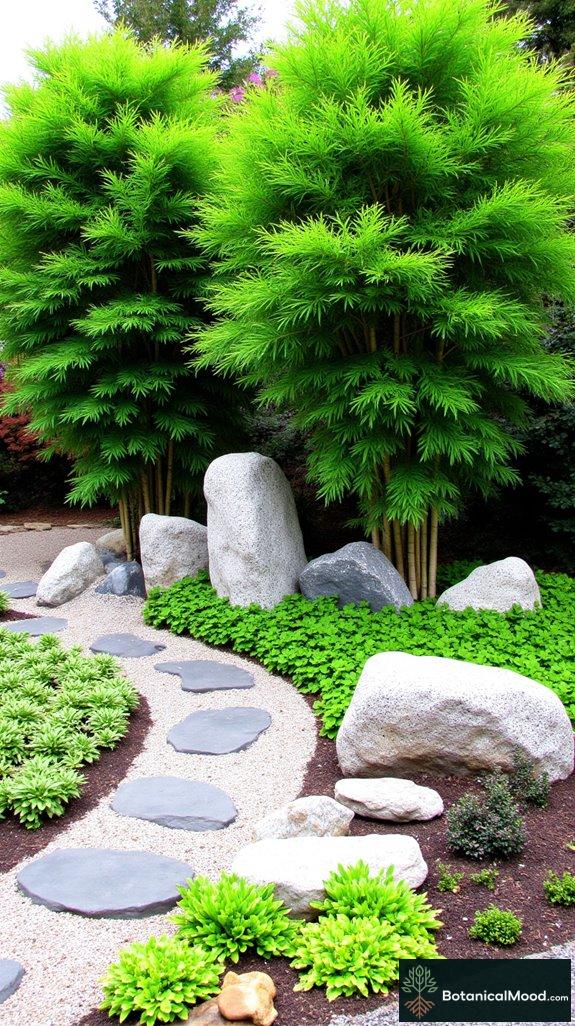
A bamboo and stone combination planting bed creates a serene and naturalistic aesthetic, blending vibrant green bamboo with textured stones. Ideal dimensions are 4 to 10 feet wide, allowing for ample space to showcase plants. Arrange bamboo as the structural element, complemented by decorative stones for contrast.
Use materials like granite boulders, river stones, and organic mulches for a cohesive look. Select varieties of clumping bamboo, such as Fargesia or Phyllostachys, and integrate colorful ground covers like moss, ferns, or hostas.
How to Choose Plants for a Bamboo and Stone Planting Bed
Select plants that thrive in partial to full shade and harmonize with bamboo’s vertical lines. Consider the following:
- Fargesia murielae (Umbrella Bamboo)
- Athyrium niponicum (Japanese Painted Fern)
- Creeping Thyme
- Hostas (various cultivars)
- Epimedium (Bishop’s Hat)
Planning and Designing a Bamboo and Stone Planting Bed
For design, create a flowing layout with an asymmetric arrangement for a natural feel. Here are tips:
- Place taller bamboo plants at the back or center.
- Arrange stones in clusters to mimic natural formations.
- Space plants based on their mature size (12-24 inches apart for ground covers).
- Use curves and angles when laying out stones for visual interest.
Pro Tip: Mix various stone sizes to enhance texture and depth.
Seasonal Care and Maintenance of Bamboo and Stone Planting Beds
Maintain the bed by watering regularly, applying balanced fertilizer in spring, pruning bamboo in late winter, and monitoring for pests throughout the year.
Raised Bamboo Garden Beds

Raised bamboo garden beds offer a unique, elegant structure to any garden, ideal for cultivating flowers, herbs, and vegetables.
Typically, these beds are constructed using sturdy, treated bamboo poles, creating a natural aesthetic that enhances your environment. They can vary in size, usually spanning 4 to 8 feet in length and 2 to 4 feet in width, while the height ranges from 12 to 24 inches.
The beds can be arranged in a variety of shapes—rectangular, circular, or tiered—to maximize space and visual interest.
Suitable plants for these beds include vibrant perennials, aromatic herbs, and colorful vegetables that thrive in a cooperative growing environment.
How to Select Plants for Your Raised Bamboo Garden Bed
Choosing plants for your raised bamboo garden bed entails considering sun exposure and compatibility. Here are some recommendations:
- Basil
- Lavender
- Thyme
- Marigolds
- Cherry tomatoes
- Zinnias
Designing Your Raised Bamboo Garden Bed: Tips & Arrangements
Start by sketching your design, accounting for sunlight and space. Here are some tips:
- Choose taller plants for the back and shorter ones for the front.
- Leave sufficient space between plants (about 12-18 inches) for airflow.
- Group plants with similar water and light needs together.
Pro Tip: Consider companion planting, like positioning marigolds next to tomatoes to deter pests!
Seasonal Care and Maintenance of Your Raised Bamboo Garden Bed
For ideal growth, regularly water, fertilize with organic nutrients, prune dead foliage, and monitor for pests throughout the seasons.
Bamboo Separator Pathways

Bamboo separator pathways create stunning, nature-inspired planting beds that blend art with functionality. Typically, they encompass a size of 3-5 feet wide and extend depending on your garden layout.
Use flexible bamboo poles to create borders that outline the beds, enhancing the overall look with a natural aesthetic. Arrangement can include pathways that provide access while showcasing various plant groupings. Opt for a mix of ornamental grasses, shade-loving ferns, and vibrant flowering perennials, such as Japanese anemones or hostas, to maintain a colorful display throughout the seasons. Incorporating native woodland plants can further enhance the biodiversity and ecosystem of your garden.
Selecting Plants for Bamboo Separator Pathways
When selecting plants for your bamboo separator pathways, consider their height, color, and texture. Suitable choices include:
- Japanese Maples – for elegant foliage.
- Ferns – like the Lady Fern for lush greens.
- Bamboo Grasses – providing height and movement.
- Hydrangeas – for seasonal blooms in various colors.
Designing Your Bamboo Separator Pathways
To design your bamboo separator pathways, start by sketching your bed layout to visualize plant arrangement.
- Pro Tip: Group plants in odd numbers for a natural look.
- Space taller plants (like Japanese Maples) at the back and shorter ones (like ferns) in front for layered depth.
- Use bamboo as dividers for visual appeal and functionality, maintaining at least 12-18 inches between individual plants to allow growth and airflow.
Seasonal Care and Maintenance of Bamboo Separator Pathways
Consistently water your plants, apply organic fertilizers in spring, prune overgrown sections in late fall, and monitor for pests throughout the year.
Vertical Bamboo Screens
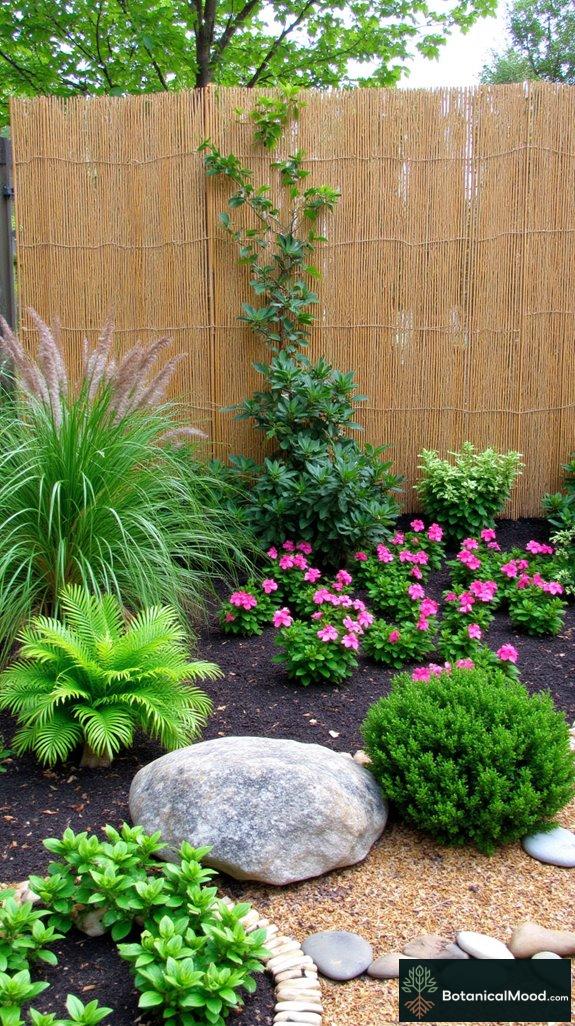
Vertical bamboo screens create an enchanting garden border that combines functionality with aesthetic appeal. Ideally ranging from 3 to 6 feet in height and 2 to 3 feet in width, these planting beds can be arranged vertically to define spaces or offer privacy.
Create captivating garden borders with vertical bamboo screens, blending beauty and functionality while providing privacy.
Commonly used materials include sturdy bamboo poles, lattice panels, or wooden frames. Complementing plants are typically low-maintenance species such as ferns, moss, or flowering perennials that thrive in shaded, moist areas. The overall layout aims to create a serene, Zen-like atmosphere reminiscent of traditional Japanese gardens.
How to Select Plants for Vertical Bamboo Screens
Selecting the right plants for vertical bamboo screens is essential for achieving balance and harmony. Consider the following plants:
- Japanese Forest Grass (Hakonechloa macra)
- Maidenhair Fern (Adiantum)
- Hellebores
- Bamboo Lily (Cardiocrinum giganteum)
- Hostas
- Impatiens (for splashes of color)
Designing and Planning Your Vertical Bamboo Screen Planting Bed
To design an inviting vertical bamboo screen planting bed, keep these tips in mind:
- Assess sunlight and shade; most bamboo appreciates partial shade.
- Select varying heights — taller plants in the back, shorter in front.
- Space plants adequately (about 12-18 inches apart) for airflow and growth.
- Use organic mulch to maintain moisture and suppress weeds.
Pro tip: Incorporate decorative stones or gravel at the base to enhance the aesthetics and prevent soil erosion.
Seasonal Care and Maintenance of Vertical Bamboo Screens
Regularly water your bamboo and plants, fertilize in early spring, prune dead or overgrown shoots, and watch for pests throughout the year for a thriving vertical bamboo garden.
Rustic Bamboo Frames
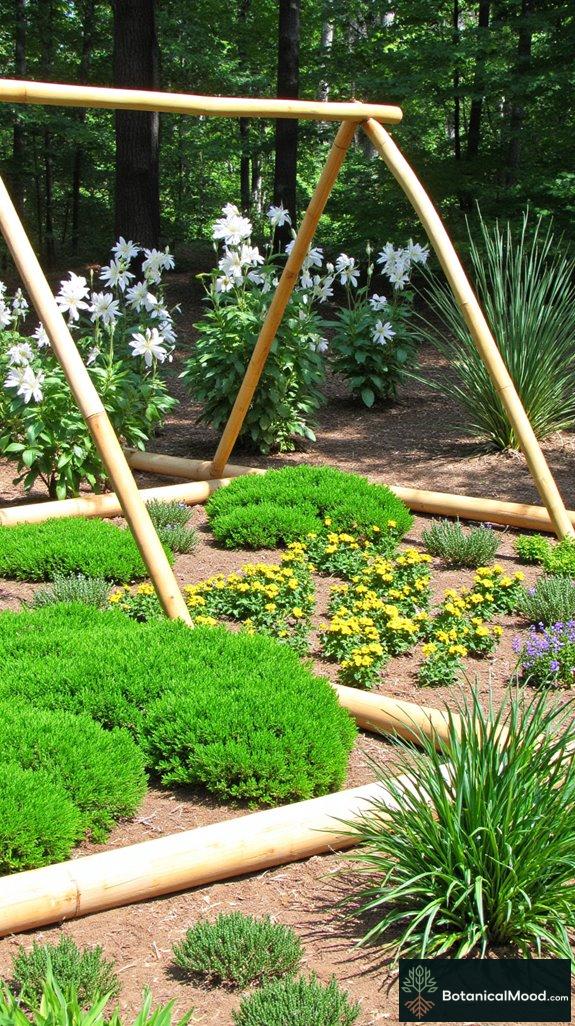
Rustic bamboo frames are a charming way to create garden borders. Typically, these frames are made of untreated bamboo poles that measure around 4 to 6 feet long, arranged to create a rectangular or circular planting bed.
They offer a natural, organic appearance while providing structure to your garden. Perfect for small to medium-sized beds, they can showcase diverse plant arrangements featuring low-growing ground covers like creeping thyme, colorful perennials such as daylilies, and ornamental grasses like Japanese forest grass.
To create the frame, treat the bamboo with a protective finish, if desired, and make sure it’s securely anchored in the soil.
How to Select Plants for Your Rustic Bamboo Frames
When selecting plants for rustic bamboo frames, consider their height, texture, and bloom time for a cohesive appearance. Suggested plants include:
- Creeping thyme (Thymus serpyllum)
- Daylilies (Hemerocallis)
- Japanese forest grass (Hakonechloa macra)
- Sedum (Sedum spp.)
- Astilbe (Astilbe spp.)
Designing and Planning Your Rustic Bamboo Frames Planting Bed
To design a rustic bamboo frames planting bed, follow these tips:
- Assess sunlight: Make sure the chosen location receives adequate sunlight for your plants.
- Prepare soil: Amend soil with compost or organic matter for peak growth.
- Layer plants: Place taller plants in the back and shorter in the front for visibility.
- Add texture: Mix foliage styles for visual interest.
For peak spacing, allow 12-18 inches between plants to encourage healthy growth and air circulation.
Seasonal Care and Maintenance for Rustic Bamboo Frames Planting Bed
Throughout the year, maintain your planting bed by regularly watering, applying balanced fertilizer in spring, pruning spent blooms, and controlling pests using organic solutions.
Bamboo Water Features
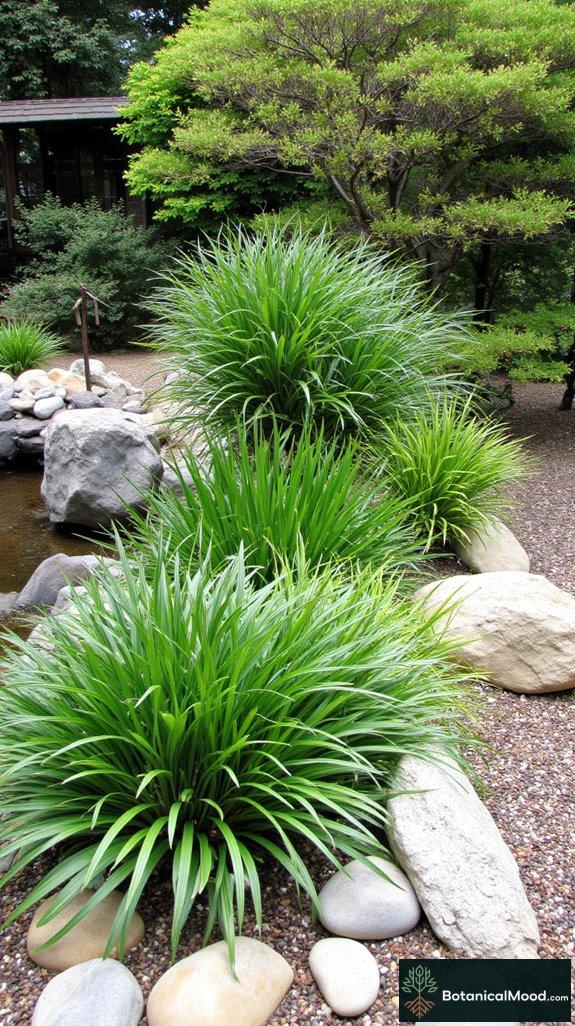
Bamboo water features create tranquil environments, beautifully marrying plants and water. For ideal size, aim for a planting bed of at least 4×6 feet to allow ample space for bamboo and surrounding flora.
Arrange bamboo at the back as a lush backdrop, complemented by decorative pebbles, stones, or a small pond. Popular plant selections include hardy bamboo species like Phyllostachys aureosulcata, and ornamental grasses such as Japanese forest grass (Hakonechloa macra). Use natural materials like smooth river rocks to enhance the garden’s aesthetic.
How to Select Plants for Bamboo Water Features
When selecting plants, prioritize those that thrive in moist conditions. Consider the following list:
- Phyllostachys aureosulcata (Golden Bamboo)
- Hakonechloa macra (Japanese Forest Grass)
- Lemongrass (Cymbopogon citratus)
- Lobelia (Lobelia spp.)
- Japanese Iris (Iris ensata)
Designing a Bamboo Water Feature Planting Bed
To design an inviting bamboo water feature, first sketch a layout that defines the placement of water sources and plant beds.
Tips for effective arrangement:
- Space bamboo plants 3-5 feet apart for growth and air circulation.
- Group ornamental grasses and perennials in clusters of three for visual impact.
- Surround water with moisture-loving plants for cohesion.
Pro Tips:
- Use varying heights for plants to create depth.
- Consider draping plants over stones to mimic a natural look.
Seasonal Care and Maintenance for Bamboo Water Features
Maintain your bamboo water features through regular watering, fertilizing every spring, pruning back dead leaves in early summer, and vigilant pest control, especially during fall and early spring.
FAQ
How Long Does Bamboo Last in Garden Applications?
In my experience, bamboo lasts quite long in garden applications. Its lifespan can reach 10-15 years depending on the species and conditions. Bamboo’s durability truly makes it a fantastic choice for any garden setting.
Is Bamboo Eco-Friendly for Garden Use?
Absolutely, I find bamboo eco-friendly for gardens! Its rapid growth rates mean it replenishes quickly, while its sustainability benefits help promote healthy ecosystems. Plus, it adds a unique aesthetic that elevates any outdoor space!
Can Bamboo Borders Hold up in Extreme Weather?
Absolutely, bamboo borders can withstand extreme weather. I’ve seen their durability in action, showcasing impressive weather resilience. With proper maintenance, they brighten up gardens, offering both beauty and strength against nature’s elements.
How Do I Maintain Bamboo Garden Borders?
I maintain my bamboo borders by regularly applying bamboo maintenance tips, like watering and mulching. I use effective bamboo pruning techniques to keep them healthy and vibrant, ensuring they flourish without feeling too constrained or invasive.
Are There Specific Bamboo Species Recommended for Borders?
When it comes to border aesthetics, I love using specific species like Fargesia murielae or Bambusa ventricosa. They create a harmonious, liberating vibe, providing both beauty and functionality in my garden’s borders.
Summary
In my garden, I’ve incorporated bamboo borders that capture Japanese aesthetics while promoting sustainability. I’m amazed how bamboo can grow 35 inches daily, making it a rapidly renewable resource. These borders create tranquil spaces that connect me with nature through eco-friendly landscaping choices.
Have you used bamboo in your garden design? I’d love to hear how it transformed your outdoor space and what traditional Japanese elements you’ve incorporated to create your own peaceful retreat.
Please share photos of your garden designs! Whether you’ve used bamboo borders, created water features, or designed rock arrangements, I’m curious to see how you’ve brought Japanese inspiration into your personal landscape.
